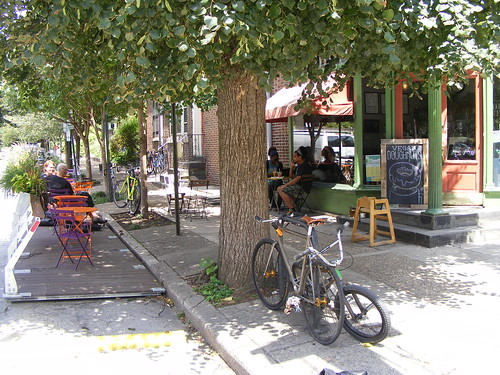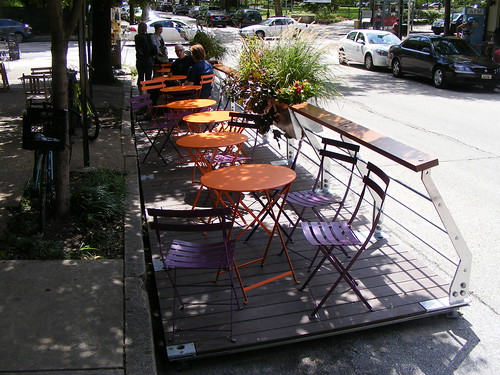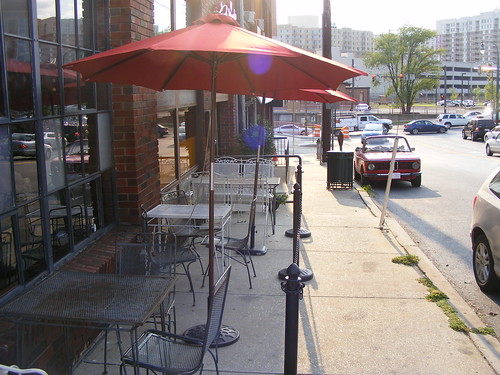Last spring, San Francisco replaced a few unused parking spaces with a little patch of green the mayor dubbed a "parklet." Though they're appearing all over the country, parklets haven't taken root in the D.C. area yet. But in Philadelphia, where JUTP is back finishing grad school, I've got one just a few blocks from my house.
Most parklets are pretty simple: a raised platform with some tables and chairs and, of course, lots of plants. Some host sculptures and artwork, while others hold bicycle parking. They're designed to "extend" the sidewalk, repurposing space once given over to cars for people. Parklets can be temporary or permanent, but they should always be inviting and comfortable for users.

Parklet outside the Green Line Cafe in West Philadelphia.
Philadelphia's first parklet was installed last month outside of the Green Line Cafe, a coffee shop with three locations in West Philadelphia. It's a prime intersection located along Baltimore Avenue, a neighborhood shopping street. Two trolley lines stop within a block, and the University of the Sciences is across the street, along with Clark Park, a large and well-loved community gathering place that hosts a big, twice-weekly farmers' market. As a result, there's a lot of people around, and a lot of foot traffic, giving the parklet plenty of use.
Most parklets are pretty simple: a raised platform with some tables and chairs and, of course, lots of plants. Some host sculptures and artwork, while others hold bicycle parking. They're designed to "extend" the sidewalk, repurposing space once given over to cars for people. Parklets can be temporary or permanent, but they should always be inviting and comfortable for users.

Philadelphia's first parklet was installed last month outside of the Green Line Cafe, a coffee shop with three locations in West Philadelphia. It's a prime intersection located along Baltimore Avenue, a neighborhood shopping street. Two trolley lines stop within a block, and the University of the Sciences is across the street, along with Clark Park, a large and well-loved community gathering place that hosts a big, twice-weekly farmers' market. As a result, there's a lot of people around, and a lot of foot traffic, giving the parklet plenty of use.

Last Saturday, my roommate and I grabbed dinner at our new favorite local carryout and gobbled up organic fried chicken in the parklet. Though it's located in front of a cafe, the parklet itself is city property and open to anyone. It's a nice way of democratizing outdoor seating. Lots of people would like to sit outside and enjoy the scenery, but not everyone may want to grab a cup of coffee while doing so.
My only disappointment with the parklet is that it's located across from a large and well-used park. Though this creates an even more attractive setting for outdoor seating, the installation might've done more good on a block that doesn't already have lots of trees and people. Parklets are a great way to provide usable open space and aesthetic enhancement, and they should be deployed in places that lack them both.

The sidewalks outside Li'l GT Cafe in Petworth are only wide enough to hold a single table.
If the District ever starts a parklets program, the first place I'd locate one is in front of Li'l GT Cafe, the Caribbean restaurant my aunt and cousin opened earlier this year on Georgia Avenue in Petworth. Over the summer, I helped them submit an application to set up a sidewalk cafe. Unfortunately, the sidewalk is so narrow that according to city regulations, they could fit just one table with three chairs, and only after receiving a special exception.

Meanwhile, Georgia Avenue has four lanes and parking on both sides; most of the day, the spaces on their block aren't full. The area gets a lot of foot traffic, but could use some sprucing up, which makes it seem like a smart place to locate a parklet.

I prefer outdoor seating and ask for it whenever I'm at a restaurant, but I wouldn't feel comfortable eating here, four feet from the curb. Instead of street trees and plantings, diners enjoy a view of above-ground telephone poles, parking meters and trash cans. Meanwhile, Sligo Avenue, a neighborhood street a mile long, is way too wide, and cars can easily speed down it. Placing a parklet here would help slow traffic and give diners a pleasant place to enjoy their meals.
The parklet "movement" is an outgrowth of Park(ing) Day, a yearly event started by a San Francisco art collective that encourages people to repurpose metered parking spaces, in the purpose revealing just how much space we give to cars in our communities. While I don't think cars are going away anytime soon, I'm okay giving up a few parking spaces if it creates more attractive and enjoyable neighborhoods.
And if you don't think that a 180-square-foot park can't create a sublime outdoor experience, I invite you to meet me next weekend at the corner of 43rd and Baltimore in Philadelphia. I'll bring some chicken and we can watch the world go by from the middle of the street.

No comments:
Post a Comment